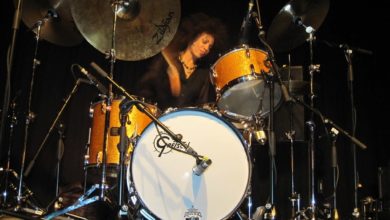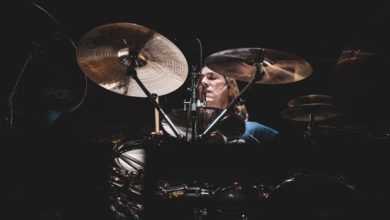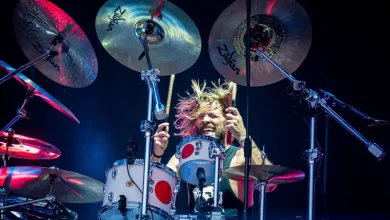
Throughout the years, it’s been hard to come by a drummer that hasn’t held Steve Jordan as one of their primary influences, or a producer, musician, bandleader that doesn’t trace back the type of groove that they want to a “Jordan” type of backbeat or feel.
It’s understandable though, as the award-winning drummer, producer, and songwriter has collaborated and worked with most of the icons and legends of the industry, such as Neil Young, The Blues Brothers, James Brown, Keith Richards, Herbie Hancock, Billy Joel, John Mayer, Eric Clapton, among many many others. Steve is a titan of the industry on its own and a reference for musicality, versatility, and musical identity.
As so, in this short article, I’ll be listing my top five albums or performances in which Steve Jordan has played, that have inspired me as a performer and composer, and have shown me why Jordan is still considered one of the living legends of drumming, and one of the greatest musicians on the American scene.
5. Continuum (2006) – John Mayer
The third studio album by the American singer-songwriter John Mayer was the first album in which I heard Jordan’s drumming and was the album that led me to listen to more funk and blues albums after it.
After some years, I discovered that Jordan played drums and percussion and was also the main producer of the album, helping with the composition and songwriting process. The album won the 49th annual Grammy awards for Best Pop Vocal Album and Best Male Pop Vocal Performance for “Waiting on the World to Change” and nominating it for the “Album of the Year” category.
In it, Jordan’s presence shines in tracks such as the mentioned “Waiting on the World to Change” in which the driving groove gives a spotlight to Jordan’s way of sitting behind the beat, syncopating the bass drum just before the snare hits to give a sense of “bounce” and movement to the beat, grounding and giving space to the tune, while moving it forward.
Other tunes, such as “Gravity” and “I’m Going to Find Another You,” show Steve’s blues background. His drumming humbly paves the way for the predominant characters of the compositions. The vocals, guitar solos, and horn sections ground the beat with a minimal approach, and very few (if there are any) fills, giving the utmost importance to the pulse movement through constant and straight hi-hat and ride strokes.
Lastly, songs such as “Vultures” and “I Don’t Trust Myself in Loving You” really paint an accurate picture of what people mean by that “Steve Jordan feel:” big hi-hats, “phat” snares, and big bass drums, that move and support the songs, giving a massive sound to the overall feel of the track.
4. Briefcase Full of Blues (1978) – The Blues Brothers
Though an album that listeners usually overlooked when getting into Jordan’s career, the Blues Brothers’ debut album “Briefcase Full of Blues,” which ended up being number 1 in the Billboard 200 and a critically acclaimed album at the time, covering a range of blues and soul songs from the ’50s and ’70s shines a light on Steve’s blues background.
It’s a specially good album to listen to Jordan’s drumming if you want to hear how masterfully he executes the blues shuffle. Tracks like “Hey Bartender” and “I Don’t Know” show a clear example of the importance of providing a steady flow behind the kit, providing enough space for the blues to be heard.
Another notable track on the album is “Messin’ With the Kid,” a soul track that gets this James Brown attitude filled with ghost notes and syncopated hi-hat accents that highlight Jordan’s technical side to which his playing is not usually related but is present.
3. Live in Sand Diego (2016) – Eric Clapton
The thirteenth live album of Eric Clapton shined a light on how much Jordan’s energy can lift a stadium with its groove—recorded at the Ipayone Center in San Diego.
It gathered a roster of titan musicians that contributed to the concert being one of the British musician’s best live shows, with J.J. Cale and Robert Cray on guitar and vocals, Doyle Bramhall II on guitar and backing vocals, Derek Trucks on slide guitar, Willie Weeks on bass and Jordan on drums.
In “Tell the Truth” and “Anyday,” the signature use of his 17″ hi-hats shine through. As he has explained in multiple interviews, hi-hats this big can get loud without compromising how the drums sound with the overall mix.
In this performance, it’s clear that they create a fantastic foundation for grudging guitars and raspy vocals to explode without having an annoyingly loud open hi-hat sound in the background.
His track performance is seamless as if no matter how loud he gets, he never gets in the way of Derek Trucks soloing. On the other hand, in the track “Got to Get Better,” big straight open hi-hats and crashes are replaced by a swinging tight hi-hat groove, with poppy snares and a tight bass drum that drives the whole tune and almost seems to be leading the vocals, and not the other way around, gluing the whole performance with Willie Weeks’s bass playing at hand.
2. Talk is Cheap (1988) – Keith Richards
This debut album by Keith Richards from the Rolling Stones as the bandleader and singer shows the versatility and power of Jordan’s playing, making it a clear example why he is featured in albums from all the range of genres, this one highlighting his rock and more gritty approach to groove.
Steve’s feature on this album came about after he came in to fill in Charlie Watts’s shoes on the Rolling Stones 1986 release “Dirty Work” after a problem with substance abuse disabled the drummer from being featured in the next Stones album.
After drumming in the mentioned record, and then being hired by Keith Richards to play in Aretha Franklin’s cover of “Jumpin’ Jack Flash” for the same-titled film, the relationship between the Stones member and Jordan grew stronger, enabling Steve to be a part of the Keith Richards and the X-pensive Winos band, with which he toured and recorded two albums, “Talk is Cheap” (1988) and “Main Offender” (1992).
On the album “Talk is Cheap,” Jordan’s powerhouse drumming shines through, and it’s one of my favorite albums in which he is featured. It’s generally the one I recommend to people when looking for a great rock album with heavily funk and blues influenced grooves.
The album features incredible chemistry between Steve and the rest of the X-pensive Winos band, with amazing tracks such as “Big Enough,” in which a walking huge tom beat with descending tom strokes, paired up with a tight poppy snare and ghosts notes that fill give some tail to the snare rim shots sync in perfectly with Charley Drayton’s funk bass, ending up abruptly and leaving you wanting for more.
In other tracks, like “Make no Mistake,” Steve lays a minimal backbeat consisting of mainly bass drum and extremely loose and low tuned snare that gives the foundation to the tune and creates enough space for the horn section and the intimate vocals of Richards and Sarah Dash to shine.
Another track showing Steve’s minimal approach FOR THE MUSIC is “Struggle”, in which the straight groove in the hi-hat goes on throughout all the song, with minimal top no breaks, and some hi-hat accents that give the groove some bounce without swinging it, much like in John Mayer’s “Waiting on the World to Change”.
With Jordan’s collaboration, the debut album by Richards achieved critical acclaim worldwide, gaining special importance in the UK and US, where it went Gold, and received terrific reviews, jokingly calling it the best Rolling Stones album in years.
1. James Brown on “Late Night with David Letterman” (1982)
Though maybe an odd choice for the first place, in my opinion, the story behind how Steve Jordan got to play with James Brown, while being the drummer on the Paul Shaffer’s “World’s Most Dangerous Band,” paints a broad picture on why nowadays Steve is still one of the most relevant drummers in the business.
James Brown’s performance in Letterman is still considered by many as one of the greatest of the show’s history. The Godfather of soul was able to play several songs at the time. The band at the time, the “World’s Most Dangerous Band,” directed by Paul Shaffer, with him on keyboards, Will Lee on bass guitar, Hiram Bullock on guitar, Sid McGinnis on guitar, Anton Fig on percussion, and Steve Jordan on drums, was ecstatic.
Regarding this performance, Shaffer explains in his memoir book “We’ll Be Here For the Rest of Our Lives: A Swingin’ Show-biz Saga,” he felt as if it was “the honor of a lifetime.”
Jordan was specifically excited about the performance with one of his idols and even got to pick one of the tunes that were going to be played.
Regarding that choice, Shaffer explains, “Steve said, “Sex Machine” for the drumming” on it, James wanted a fast tempo. That’s the tradition of live R&B. It’s all about energy. Steve Jordan, though, was a young buck who wanted to re-create the groove he’d heard on wax.
He didn’t quite understand that when you deal with the Godfather of Soul, you put the groove where he wants it. James won out, and the funk got thick (..) On James’s second appearance, he wanted to bring his own drummer. He knew that Steve was brilliant, but James wanted full control – and that meant his own drummer. This was a delicate moment.
Steve was my guy, and without him I knew we couldn’t re-create the magic of James’s first jam with us. On a personal note, I also knew Steve would be crushed to learn James was dropping him.
Then, in a moment of inspiration, I remembered James’s song from 1966, “Don’t Be a Dropout” and his lifelong campaign to keep kids in school. “James, I must tell you something about Steve” I said, “What is it, Paul?” “It’ll kill him if he doesn’t get to play.
This kid stayed in school because of you” There was a long pause before James came back with “Tell him he can play behind me. I’ll bring my own drummer and we’ll use both cats” “That’s great, James, Steve will be thrilled” Steve was thrilled, until, during rehearsal, it became clear that James was dancing only to the beat of his own drummer. Steve gallantly laid out. (..)
Happily, the James Brown/ Steve Jordan relationship was resolved in a sweetly satisfying way. A few moments later, when the Godfather was asked by a magazine to name his favorite drummer, James mentioned the great Steve Jordan.”
I believe this story, and how Brown mentioned Jordan to be his favorite drummer, encapsulates why he’s still so relevant. He has the technique, sound and energy, as we’ve seen in the mentioned records, to meet any musical expectation, but more importantly, his professionalism and “for the music” approach.
Whether it is laying down a minimal groove without any ego, stepping out of Brown’s second song, or delivering the energy necessary to lift a whole stadium, his approach enables him to be considered and extremely reliable musician for any situation, an amazing producer, and one of the most relevant figures in music nowadays, with an incredible amount of years and collaborations behind his back to prove it.
James Brown’s performance on David Letterman link:
Featured Image: Noelle Smith, CC BY 2.0 https://creativecommons.org/licenses/by/2.0, via Wikimedia Commons

About the Author
Joe Sturges is a drummer and composer. Merging classical, jazz, hip/hop, and a variety of other influences, he creates a unique and honest sound in his compositions, always aiming to tell a story with his music.



